Feet First
Feet First is a 1930 American pre-Code comedy film starring Harold Lloyd, a very popular daredevil comedian during the 1920s and early 1930s. It was Lloyd's second and most popular sound ('talkie') feature. It is also one of his 'thrill' comedies, involving him climbing up a tall building. Harold Lloyd was one of very few silent film actors who successfully adapted to sound.
| Feet First | |
|---|---|
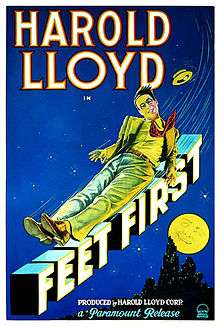 Original US release poster.(*note the similarity to Paramount's Bebe Daniels film of 1925, Wild, Wild Susan. Daniels had been Lloyd's great female costar in his years making short films. | |
| Directed by | Clyde Bruckman |
| Produced by | Harold Lloyd |
| Starring | Harold Lloyd (Harold Horne) Barbara Kent (Barbara) Robert McWade (Mr. Tanner) |
| Music by | Mischa Bakaleinikoff (uncredited) Claude Lapham (uncredited) Walter Scharf (1962 re-release) |
| Cinematography | Henry N. Kohler Walter Lundin |
| Edited by | Bernard W. Burton |
| Distributed by | Paramount Pictures |
Release date |
|
Running time | 93 minutes |
| Country | United States |
| Language | English |
| Budget | $647,353[1] |
Plot
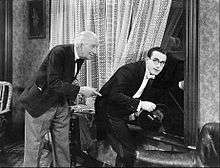
Harold Horne, an ambitious shoe salesman in Honolulu, unknowingly meets the boss's secretary Barbara (Barbara Kent) - thinking she is the boss's daughter - and tells her he is a millionaire leather tycoon.
Horne spends much of his time around Barbara hiding his true circumstances, in both the shoe store and later as an (accidental) stowaway on board a ship. Trying to evade the ship's crew, he becomes trapped in a mailbag, which is taken off the ship and falls off a delivery cart onto a window cleaner's cradle, which is hoisted upwards. Escaping from the bag, he finds himself dangling high above the streets of Los Angeles. After several thwarted attempts to get inside the building, he climbs to the very top, only to slip off - unaware his foot is caught on the end of a rope, which rescues him inches from the ground.
Cast
- Harold Lloyd as Harold Horne
- Barbara Kent as Barbara
- Robert McWade as John Quincy Tanner
- Lillian Leighton as Mrs Tanner
- Henry Hall as Endicott
- Noah Young as Sailor
- Alec B. Francis as Mr Carson
- Arthur Housman as Drunken Clubman
- Willie Best as Janitor
- Nick Copeland as Man Arguing With Friend
- James Finlayson as Painter
- Buster Phelps as Little Boy
- Leo Willis as Truck Driver
Production
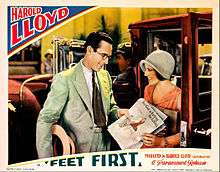
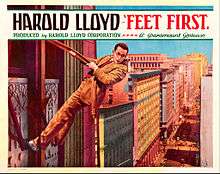
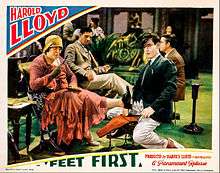
Co-star
This was the second film with Barbara Kent, and the last occasion on which Lloyd would appear with the same leading lady.
Stunts
The "hanging outside of the skyscraper" sequence used techniques similar to those on Lloyd's most famous film, the silent Safety Last! (1923). Contrary to some Hollywood lore, this scene did not utilize special effects or back projection. Before the scene in the 1962 compilation film Harold Lloyd's World of Comedy (produced by Harold Lloyd himself), a title card reads as follows:
"This sequence was made without trick photography and before process was perfected. The action — at all times — actually occurred as high up as you see it happen."
Whilst this is technically true, the impression of height was achieved by the construction of a skyscraper façade on the roof of another structure: in this case the Southern California Gas Company Building, South Broadway, Los Angeles. Lloyd had already used this technique in Safety Last!, and indeed the location used for that earlier film was only a few blocks away from this one.[2] Additionally, the concluding sequence of the climb, where Harold Horne falls from the building with a rope attached to his foot, does briefly use back-projection for a mid shot.
Re-releases
The film was re-released in the 1960s as part of the feature, Harold Lloyd's World of Comedy where Lloyd felt it was necessary to overdub part of his original dialogue; (see below). Lloyd also added a dramatic underscore to the climb sequence, composed by Walter Scharf. In the original release this scene had no music.
The film was re-released again in segments as part of Time-Life's Harold Lloyd's World of Comedy television series in the 1970s. However, since the majority of the clips in the series came from silent films, the sound track was removed as if to imply that it too was a silent film. It has since been released on DVD in its correct format.
Period characteristics
This film contains a classic example of Hollywood's use of an African American in a comic "shiftless and slow" stereotyped role. In the original release, while hanging outside of a skyscraper window, Lloyd's character attempts to obtain the assistance of a janitor played by Willie Best (billed in this film under the moniker "Sleep 'n' Eat") whom he nicknames on the spot as "Charcoal." In the 1960s re-release, to avoid accusations of racial stereotyping, Lloyd overdubbed his own voice to change the name of the character to "Charlie."
See also
- List of American films of 1930
- List of United States comedy films
References
- Vance, Jeffrey and Suzanne Lloyd. "Harold Lloyd: Master Comedian" New York: Harry N Abrams. p 171
- Bengtson, John (January 14, 2012). "The Artist Locations Part 3, Harold Lloyd, and Safety Last!". Retrieved August 1, 2018.
External links
| Wikimedia Commons has media related to Feet First. |